Chapter 6 Astronomical Instruments
6.1 Telescopes
Learning Objectives
By the end of this section, you will be able to:
- Describe the three basic components of a modern system for measuring astronomical sources
- Describe the main functions of a telescope
- Describe the two basic types of visible-light telescopes and how they form images
Systems for Measuring Radiation
There are three basic components of a modern system for measuring radiation from astronomical sources. First, there is a telescope, which serves as a “bucket” for collecting visible light (or radiation at other wavelengths, as shown in Figure 1. Just as you can catch more rain with a garbage can than with a coffee cup, large telescopes gather much more light than your eye can. Second, there is an instrument attached to the telescope that sorts the incoming radiation by wavelength. Sometimes the sorting is fairly crude. For example, we might simply want to separate blue light from red light so that we can determine the temperature of a star. But at other times, we want to see individual spectral lines to determine what an object is made of, or to measure its speed (as explained in the Radiation and Spectra chapter). Third, we need some type of detector, a device that senses the radiation in the wavelength regions we have chosen and permanently records the observations.
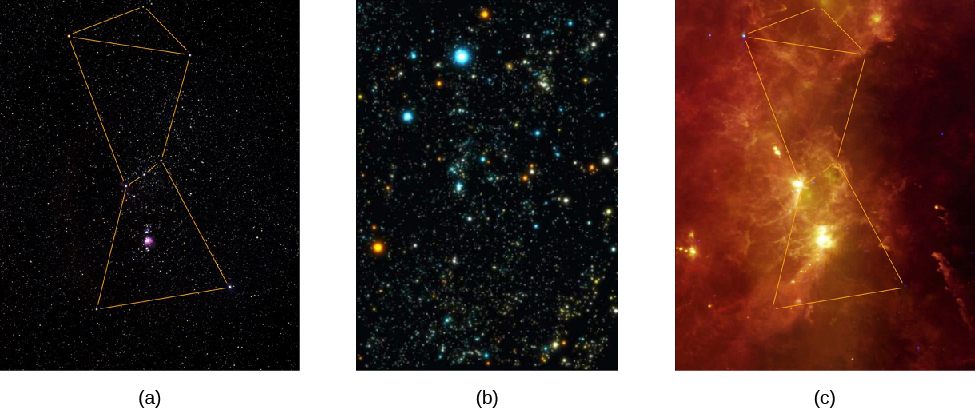
The history of the development of astronomical telescopes is about how new technologies have been applied to improve the efficiency of these three basic components: the telescopes, the wavelength-sorting device, and the detectors. Let’s first look at the development of the telescope.
Many ancient cultures built special sites for observing the sky as shown in Figure 2. At these ancient observatories, they could measure the positions of celestial objects, mostly to keep track of time and date. Many of these ancient observatories had religious and ritual functions as well. The eye was the only device available to gather light, all of the colours in the light were observed at once, and the only permanent record of the observations was made by human beings writing down or sketching what they saw.

While Hans Lippershey, Zaccharias Janssen, and Jacob Metius are all credited with the invention of the telescope around 1608—applying for patents within weeks of each other—it was Galileo who, in 1610, used this simple tube with lenses (which he called a spyglass) to observe the sky and gather more light than his eyes alone could. Even his small telescope—used over many nights—revolutionized ideas about the nature of the planets and the position of Earth.
How Telescopes Work
Telescopes have come a long way since Galileo’s time. Now they tend to be huge devices; the most expensive cost hundreds of millions to billions of dollars. (To provide some reference point, however, keep in mind that just renovating college football stadiums typically costs hundreds of millions of dollars—with the most expensive recent renovation, at Texas A&M University’s Kyle Field, costing ?450 million.) The reason astronomers keep building bigger and bigger telescopes is that celestial objects—such as planets, stars, and galaxies—send much more light to Earth than any human eye (with its tiny opening) can catch, and bigger telescopes can detect fainter objects. If you have ever watched the stars with a group of friends, you know that there’s plenty of starlight to go around; each of you can see each of the stars. If a thousand more people were watching, each of them would also catch a bit of each star’s light. Yet, as far as you are concerned, the light not shining into your eye is wasted. It would be great if some of this “wasted” light could also be captured and brought to your eye. This is precisely what a telescope does.
The most important functions of a telescope are (1) to collect the faint light from an astronomical source and (2) to focus all the light into a point or an image. Most objects of interest to astronomers are extremely faint: the more light we can collect, the better we can study such objects. (And remember, even though we are focusing on visible light first, there are many telescopes that collect other kinds of electromagnetic radiation.)
Telescopes that collect visible radiation use a lens or mirror to gather the light. Other types of telescopes may use collecting devices that look very different from the lenses and mirrors with which we are familiar, but they serve the same function. In all types of telescopes, the light-gathering ability is determined by the area of the device acting as the light-gathering “bucket.” Since most telescopes have mirrors or lenses, we can compare their light-gathering power by comparing the apertures, or diameters, of the opening through which light travels or reflects.
The amount of light a telescope can collect increases with the size of the aperture. A telescope with a mirror that is 4 meters in diameter can collect 16 times as much light as a telescope that is 1 meter in diameter. (The diameter is squared because the area of a circle equals πd2/4, where d is the diameter of the circle.)
Calculating the Light-Collecting Area
What is the area of a 1-m diameter telescope? A 4-m diameter one?
Solution
Using the equation for the area of a circle,
the area of a 1-m telescope is
and the area of a 4-m telescope is
Check Your Learning
Show that the ratio of the two areas is 16:1.
Therefore, with 16 times the area, a 4-m telescope collects 16 times the light of a 1-m telescope.
After the telescope forms an image, we need some way to detect and record it so that we can measure, reproduce, and analyze the image in various ways. Before the nineteenth century, astronomers simply viewed images with their eyes and wrote descriptions of what they saw. This was very inefficient and did not lead to a very reliable long-term record; you know from crime shows on television that eyewitness accounts are often inaccurate.
In the nineteenth century, the use of photography became widespread. In those days, photographs were a chemical record of an image on a specially treated glass plate. Today, the image is generally detected with sensors similar to those in digital cameras, recorded electronically, and stored in computers. This permanent record can then be used for detailed and quantitative studies. Professional astronomers rarely look through the large telescopes that they use for their research.
Formation of an Image by a Lens or a Mirror
Whether or not you wear glasses, you see the world through lenses; they are key elements of your eyes. A lens is a transparent piece of material that bends the rays of light passing through it. If the light rays are parallel as they enter, the lens brings them together in one place to form an image as shown in Figure 3. If the curvatures of the lens surfaces are just right, all parallel rays of light (say, from a star) are bent, or refracted, in such a way that they converge toward a point, called the focus of the lens. At the focus, an image of the light source appears. In the case of parallel light rays, the distance from the lens to the location where the light rays focus, or image, behind the lens is called the focal length of the lens.
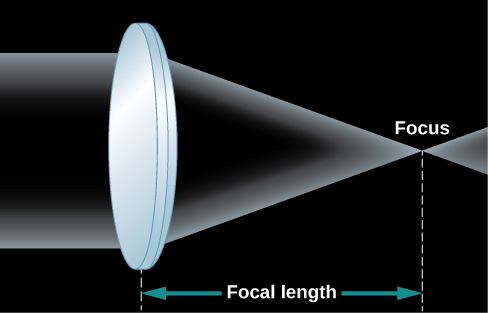
As you look at Figure 3, you may ask why two rays of light from the same star would be parallel to each other. After all, if you draw a picture of star shining in all directions, the rays of light coming from the star don’t look parallel at all. But remember that the stars (and other astronomical objects) are all extremely far away. By the time the few rays of light pointed toward us actually arrive at Earth, they are, for all practical purposes, parallel to each other. Put another way, any rays that were not parallel to the ones pointed at Earth are now heading in some very different direction in the universe.
Crash Course Physics has two very good videos about light, lenses and optical instruments https://youtu.be/SddBPTcmqOk
https://youtu.be/SddBPTcmqOk
To view the image formed by the lens in a telescope, we use an additional lens called an eyepiece. The eyepiece focuses the image at a distance that is either directly viewable by a human or at a convenient place for a detector. Using different eyepieces, we can change the magnification (or size) of the image and also redirect the light to a more accessible location. Stars look like points of light, and magnifying them makes little difference, but the image of a planet or a galaxy, which has structure, can often benefit from being magnified.
Many people, when thinking of a telescope, picture a long tube with a large glass lens at one end. This design, which uses a lens as its main optical element to form an image, as we have been discussing, is known as a refractor, as shown in Figure 4, and a telescope based on this design is called a refracting telescope. Galileo’s telescopes were refractors, as are today’s binoculars and field glasses. However, there is a limit to the size of a refracting telescope. The largest one ever built was a 49-inch refractor built for the Paris 1900 Exposition, and it was dismantled after the Exposition. Currently, the largest refracting telescope is the 40-inch refractor at Yerkes Observatory in Wisconsin.
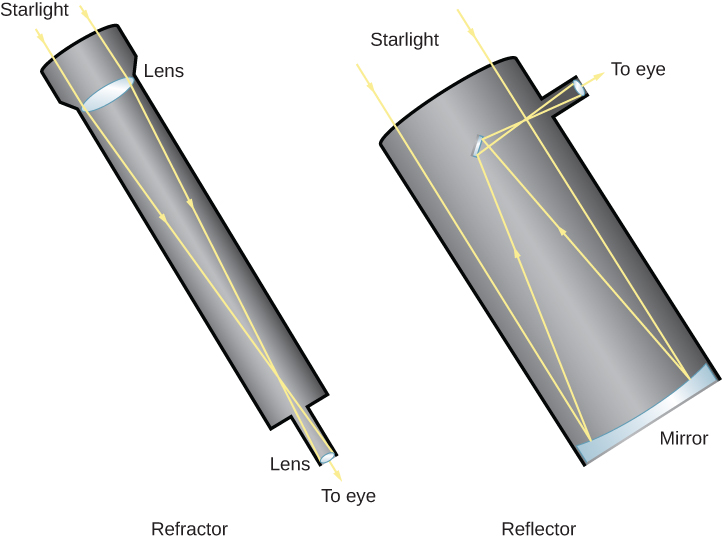
One problem with a refracting telescope is that the light must pass through the lens of a refractor. That means the glass must be perfect all the way through, and it has proven very difficult to make large pieces of glass without flaws and bubbles in them. Also, optical properties of transparent materials change a little bit with the wavelengths (or colours) of light, so there is some additional distortion, known as chromatic aberration. Each wavelength focuses at a slightly different spot, causing the image to appear blurry.
In addition, since the light must pass through the lens, the lens can only be supported around its edges (just like the frames of our eyeglasses). The force of gravity will cause a large lens to sag and distort the path of the light rays as they pass through it. Finally, because the light passes through it, both sides of the lens must be manufactured to precisely the right shape in order to produce a sharp image.
A different type of telescope uses a concave primary mirror as its main optical element. The mirror is curved like the inner surface of a sphere, and it reflects light in order to form an image as shown in Figure 4. Telescope mirrors are coated with a shiny metal, usually silver, aluminum, or, occasionally, gold, to make them highly reflective. If the mirror has the correct shape, all parallel rays are reflected back to the same point, the focus of the mirror. Thus, images are produced by a mirror exactly as they are by a lens.
Telescopes designed with mirrors avoid the problems of refracting telescopes. Because the light is reflected from the front surface only, flaws and bubbles within the glass do not affect the path of the light. In a telescope designed with mirrors, only the front surface has to be manufactured to a precise shape, and the mirror can be supported from the back. For these reasons, most astronomical telescopes today (both amateur and professional) use a mirror rather than a lens to form an image; this type of telescope is called a reflecting telescope. The first successful reflecting telescope was built by Isaac Newton in 1668.
In a reflecting telescope, the concave mirror is placed at the bottom of a tube or open framework. The mirror reflects the light back up the tube to form an image near the front end at a location called the prime focus. The image can be observed at the prime focus, or additional mirrors can intercept the light and redirect it to a position where the observer can view it more easily as shown in Figure 5. Since an astronomer at the prime focus can block much of the light coming to the main mirror, the use of a small secondary mirror allows more light to get through the system.
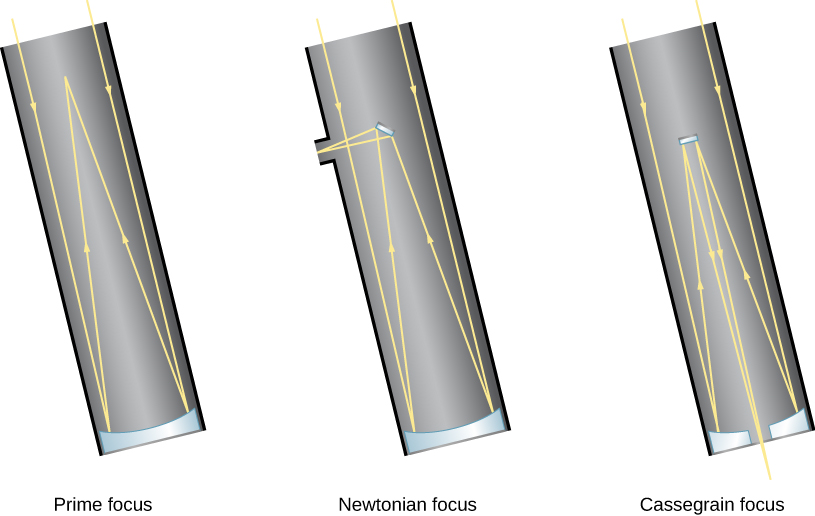
If the astronomy course you are taking whets your appetite for exploring the sky further, you may be thinking about buying your own telescope. Many excellent amateur telescopes are available, and some research is required to find the best model for your needs. Some good sources of information about personal telescopes are the two popular US magazines aimed at amateur astronomers: Sky & Telescope and Astronomy. Both carry regular articles with advice, reviews, and advertisements from reputable telescope dealers.
Some of the factors that determine which telescope is right for you depend upon your preferences:
- Will you be setting up the telescope in one place and leaving it there, or do you want an instrument that is portable and can come with you on outdoor excursions? How portable should it be, in terms of size and weight?
- Do you want to observe the sky with your eyes only, or do you want to take photographs? (Long-exposure photography, for example, requires a good clock drive to turn your telescope to compensate for Earth’s rotation.)
- What types of objects will you be observing? Are you interested primarily in comets, planets, star clusters, or galaxies, or do you want to observe all kinds of celestial sights?
You may not know the answers to some of these questions yet. For this reason, you may want to “test-drive” some telescopes first. Most communities have amateur astronomy clubs that sponsor star parties open to the public. The members of those clubs often know a lot about telescopes and can share their ideas with you. Your instructor may know where the nearest amateur astronomy club meets; or, to find a club near you, use a good search engine. In Canada, the Royal Astronomical Society of Canada keeps an up to date list. The Vancouver chapter is Jennifer Kirkey’s favourite. https://www.rasc.ca/
Furthermore, you may already have an instrument like a telescope at home (or have access to one through a relative or friend). Many amateur astronomers recommend starting your survey of the sky with a good pair of binoculars. These are easily carried around and can show you many objects not visible (or clear) to the unaided eye.
When you are ready to purchase a telescope, you might find the following ideas useful:
- The key characteristic of a telescope is the aperture of the main mirror or lens; when someone says they have a 6-inch or 8-inch telescope, they mean the diameter of the collecting surface. The larger the aperture, the more light you can gather, and the fainter the objects you can see or photograph.
- Telescopes of a given aperture that use lenses (refractors) are typically more expensive than those using mirrors (reflectors) because both sides of a lens must be polished to great accuracy. And, because the light passes through it, the lens must be made of high-quality glass throughout. In contrast, only the front surface of a mirror must be accurately polished.
- Magnification is not one of the criteria on which to base your choice of a telescope. As we discussed, the magnification of the image is done by a smaller eyepiece, so the magnification can be adjusted by changing eyepieces. However, a telescope will magnify not only the astronomical object you are viewing but also the turbulence of Earth’s atmosphere. If the magnification is too high, your image will shimmer and shake and be difficult to view. A good telescope will come with a variety of eyepieces that stay within the range of useful magnification.
- The mount of a telescope (the structure on which it rests) is one of its most critical elements. Because a telescope shows a tiny field of view, which is magnified significantly, even the smallest vibration or jarring of the telescope can move the object you are viewing around or out of your field of view. A sturdy and stable mount is essential for serious viewing or photography (although it clearly affects how portable your telescope can be).
- A telescope requires some practice to set up and use effectively. Don’t expect everything to go perfectly on your first try. Take some time to read the instructions. If a local amateur astronomy club is nearby, use it as a resource.
A telescope collects the faint light from astronomical sources and brings it to a focus, where an instrument can sort the light according to wavelength. Light is then directed to a detector, where a permanent record is made. The light-gathering power of a telescope is determined by the diameter of its aperture, or opening—that is, by the area of its largest or primary lens or mirror. The primary optical element in a telescope is either a convex lens (in a refracting telescope) or a concave mirror (in a reflector) that brings the light to a focus. Most large telescopes are reflectors; it is easier to manufacture and support large mirrors because the light does not have to pass through glass.
Canadian Telescopes of Historical Importance
Dominion Astrophysical Observatory in Victoria, British Columbia, Canada
Since becoming operational in 1918, the 1.8 metre Plaskett has accumulated nearly a century of upgrades that make it 10,000 times more sensitive than when it was first built. The 1.8-m Plaskett Telescope can perform optical imaging as well as spectroscopy. The Observatory has been designated a national historic site because of its important role in establishing Canada’s international scientific reputation in astronomy. Over the decades, these telescopes have contributed significantly to our understanding of the rotation, size and mass of the Milky Way, and of the rarefied interstellar medium between the stars. Recent projects include orbital determination of comets and asteroids, spectroscopy of magnetic stars, and ongoing studies of distant quasars and galaxies. A group called Friends of the Observatory is working to restore the glory of this telescope and conducts tours and star parties in the summer. https://centreoftheuniverse.org/
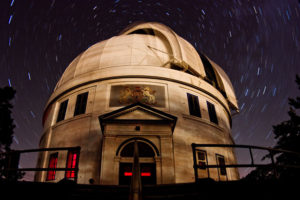
David Dunlap Observatory in Richmond Hill, Ontario, Canada
This opened in 1935. The David Dunlap Observatory (DDO) is the largest telescope in Canada. A number of important studies have taken place here, including providing the first direct evidence that Cygnus X-1 was a black hole, pioneering measurements of the distance to globular clusters and the discovery that Polaris was stabilizing. The DDO property was 76.5 hectares (189 acres) bordered by Hillsview Drive to the north, Bayview Avenue to the east, 16th Avenue to the south and the Canadian National Railway Bala Line to the west. The property was the site of a 19th century farmstead owned by Alexander Marsh, comprised of a brick farmhouse, a lane from Yonge Street, agricultural fields with hedgerows and an orchard.
The University of Toronto constructed the Observatory on the site. It included a dome, housing a 74-inch (1.88m) reflector telescope, and an Administration Building, with three smaller telescope domes. When construction was complete in 1935, the main telescope was the second largest in the world and the largest in Canada.
On September 29, 2009, Richmond Hill Council designated the DDO Property as a “property of cultural heritage value or interest” under Part IV, Section 29 of the Ontario Heritage Act.

Glossary
- aperture
- diameter of the primary lens or mirror of a telescope
- chromatic aberration
- distortion that causes an image to appear fuzzy when each wavelength coming into a transparent material focuses at a different spot
- detector
- device sensitive to electromagnetic radiation that makes a record of astronomical observations
- eyepiece
- magnifying lens used to view the image produced by the objective lens or primary mirror of a telescope
- focus
- (of telescope) point where the rays of light converged by a mirror or lens meet
- prime focus
- point in a telescope where the objective lens or primary mirror focuses the light
- reflecting telescope
- telescope in which the principal light collector is a concave mirror
- refracting telescope
- telescope in which the principal light collector is a lens or system of lenses
- telescope
- instrument for collecting visible-light or other electromagnetic radiation

